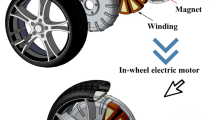Abstract
PMSM and AFPM are two different types of permanent magnet motors that convert electrical energy into mechanical energy and are used in many industrial applications. These motors are ahead of other motor types, especially in terms of energy efficiency and power density. In unmanned aerial vehicles, it is a great advantage to use a low weight and low volume propulsion provider. Moreover, the low level of acoustic noise is important for UAVs. In this paper, a new coreless AFPM (C-AFPM) was designed, and the prototype was carried out to achieve low acoustic noise. The acoustic performance of six-step and FOC commutation techniques was observed. As a result, it has been seen that an AFPM driven with the FOC control technique emits around 30% lower acoustic noise than the scenario driven by the six-step technique with the new C-AFPM machine for UAVs.









Similar content being viewed by others
Data availability
The responsible author can be contacted via e-mail for the materials used in the study and all data generated.
Abbreviations
- \({\varnothing }_{\delta }\) :
-
Magnet flux crossing air gap in Weber
- \({T}_{cog}\) :
-
Cogging torque in Newton-meter
- \(R\) :
-
Total reluctance through flux passes (1)
- \({\vartheta }_{r}\) :
-
Mechanical position of the rotor
- \({T}_{ksin}\) :
-
Amplitude of k-th harmonic for sine part
- \({T}_{kcos}\) :
-
Amplitude of k-th harmonic for cosine part
- \(LCM\) :
-
Least common multiple of number of slots Q and number of poles 2p
- \({\text{T}}\) :
-
Electromagnetic torque in Newton-meter
- \({\text{J}}\) :
-
Moment of inertia in Kg.m2
- \({T}_{l}\) :
-
Load torque
- \(B\) :
-
Coefficient of friction Kg/ms
- BEMF:
-
Back electromotive force
- \(V\) :
-
DC voltage in Volts
- \(L\) :
-
Inductance of windings in Henry
- \(R\) :
-
Resistance of the windings in Ohms
- \(E\) :
-
Back EMF of the motor
- \(i\) :
-
Current in Ampere
- \({V}_{a},{V}_{b},{V}_{c}\) :
-
Phase voltage for a, b, c phases in Volts
- \({i}_{a},{i}_{b},{i}_{c}\) :
-
Motor input current for a, b, c phases in Ampere
- \({e}_{a},{e}_{b},{e}_{c}\) :
-
Motor back EMF voltage for a, b, c phases in Volts
- RPM:
-
Revolutions per minute
References
Hao Z, Ma Y, Wang P, Luo G, Chen Y (2022) A review of axial-flux permanent-magnet motors topological structures design optimization and control techniques. Machines. https://doi.org/10.3390/machines10121178
Xia B, Shen JX, Luk PCK, Fei W (2015) Comparative study of air-cored axial-flux permanent-magnet machines with different stator winding configurations. IEEE Trans Industr Electron 62(2):846–856. https://doi.org/10.1109/TIE.2014.2353012
Syed Q, Kurtovic H, Hahn I (2017) Double stator and single rotor type single-phase flux switching axial flux permanent magnet motor. In: 20th International Conference on Electrical Machines and Systems (ICEMS): 11–14 Aug. 2017.
Kanapara J, Badgujar KP (2020) Performance improvement of permanent magnet brushless DC motor through cogging torque reduction techniques. In: 2020 21st National Power Systems Conference, NPSC 2020, https://doi.org/10.1109/NPSC49263.2020.9331855.
Sumega M, Zoššák Š, Varecha P, Rafajdus P (2019) Sources of torque ripple and their influence in BLDC motor drives. Transp Res Procedia 40:519–526. https://doi.org/10.1016/j.trpro.2019.07.075
Urasakl N, Senjyul T, Kinjol T, Uezatol K, Funabashl T, Sekinel H (2005) Dead-time compensation strategy for permanent magnet synchronous motor drive taking zero current clamp and parasitic capacitor effects into account.
Park SJ, Park HW, Lee MH, Harashima F (2000) A new approach for minimum-torque-ripple maximum-efficiency control of BLDC motor. IEEE Trans Industr Electron 47(1):109–114. https://doi.org/10.1109/41.824132
Lee HJ, Chung SU, Hwang SM (2008) Noise source identification of a BLDC motor. J Mech Sci Technol 22(4):708–713. https://doi.org/10.1007/s12206-008-0110-9
Jin CS, Kim CM, Kim IJ, Jang I (2021) Proposed commutation method for performance improvement of brushless dc motor. Energies (Basel). https://doi.org/10.3390/en14196023
Viswanathan V, Jeevananthan S (2013) A novel space-vector current control method for commutation torque ripple reduction of brushless DC motor drive. Arab J Sci Eng 38(10):2773–2784. https://doi.org/10.1007/s13369-012-0490-0
Kim TS, Ahn SC, Hyun DS (2001) A new current control algorithm for torque ripple reduction of BLDC motors. IECON Proc (Ind Electron Conf) 2:1521–1526. https://doi.org/10.1109/iecon.2001.976016
Shao L, Navaratne R, Popescu M, Liu G (2021) Design and construction of axial-flux permanent magnet motors for electric propulsion applications-a review. IEEE Access, 9. Institute of Electrical and Electronics Engineers Inc., 158998–159017. https://doi.org/10.1109/ACCESS.2021.3131000
Tehrani GG, Dardel M, Pashaei MH (2020) Passive vibration absorbers for vibration reduction in the multi-bladed rotor with rotor and stator contact. Acta Mech 231(2):597–623. https://doi.org/10.1007/s00707-019-02557-x
Lee HJ, Chung SU, Hwang SM (2008) Noise source identification of a BLDC motor. J Technol 22(4):708–713. https://doi.org/10.1007/s12206-008-0110-9
AN1946 Application Note, Sensorless BLDC Motor Control and BEMF Sampling Methods with ST7MC, 2
Acknowledgements
This work supported by Electric, Unmanned and Autonomous Vehicles Research & Application Center (AUTONOM), Altinbas University, Türkiye.
Funding
No funding was received for this study.
Author information
Authors and Affiliations
Contributions
In this study, FK made an effort in the implementation of simulation and experimental studies and in writing the body part of the article. EA made an effort in the technical review of the article and in writing the introduction part.
Corresponding author
Ethics declarations
Conflict of interest
The authors of this paper declare that this submission has no conflict of interest.
Ethical approval
Not Applicable.
Additional information
Publisher's Note
Springer Nature remains neutral with regard to jurisdictional claims in published maps and institutional affiliations.
Rights and permissions
Springer Nature or its licensor (e.g. a society or other partner) holds exclusive rights to this article under a publishing agreement with the author(s) or other rightsholder(s); author self-archiving of the accepted manuscript version of this article is solely governed by the terms of such publishing agreement and applicable law.
About this article
Cite this article
Kurtulus, F., Akboy, E. A comparasion of the effects of different commutation techniques on acoustic noise in AFPM UAV motors. Electr Eng (2024). https://doi.org/10.1007/s00202-024-02358-z
Received:
Accepted:
Published:
DOI: https://doi.org/10.1007/s00202-024-02358-z




